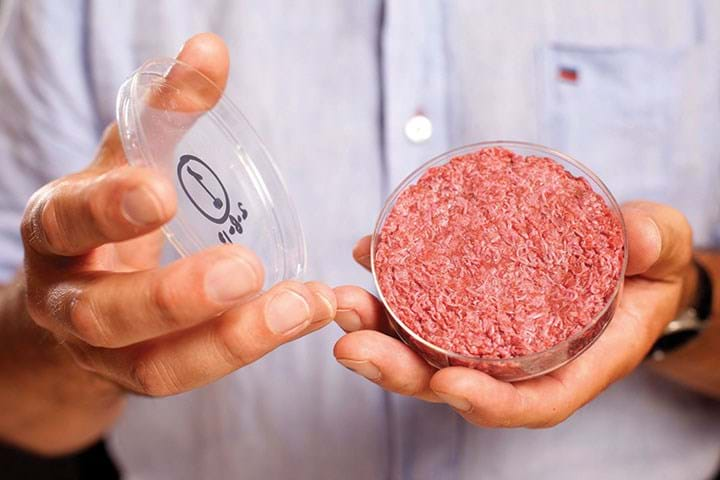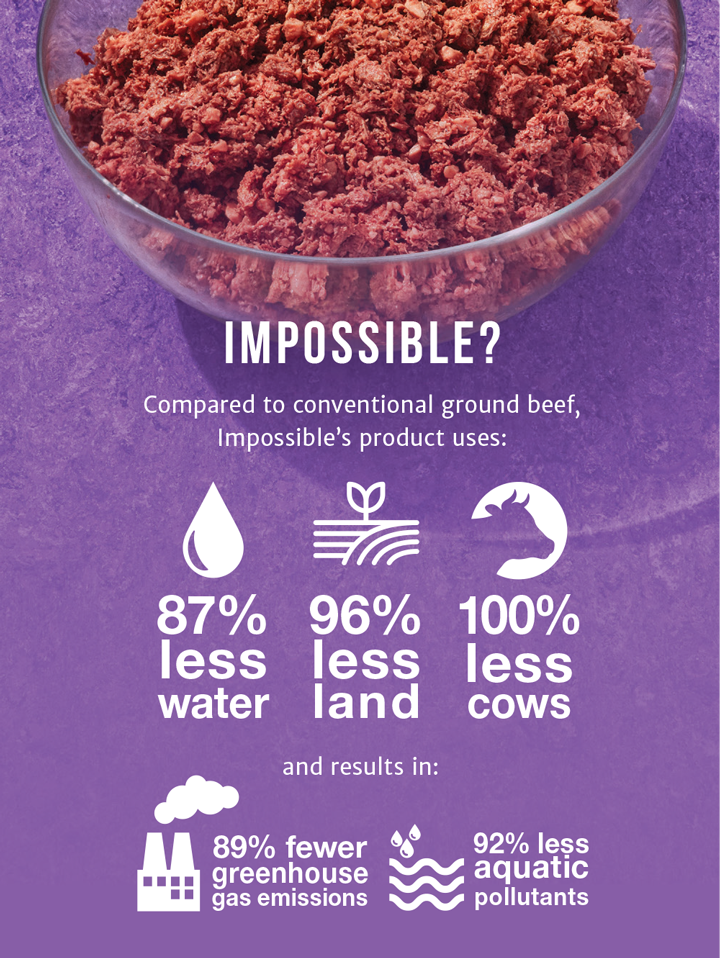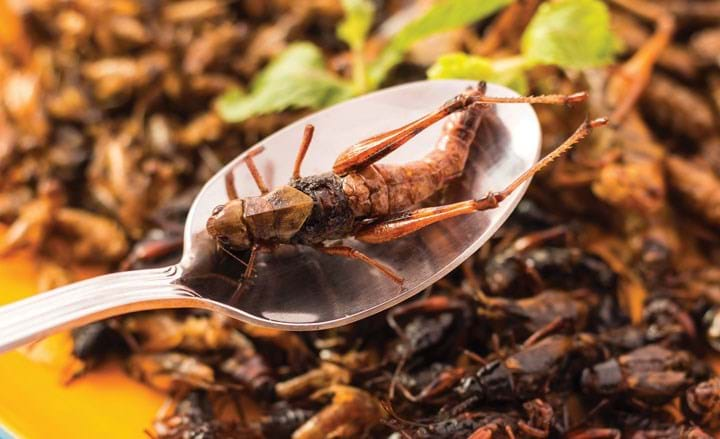Novel Meat for a New Age
Protein sources are gaining increasing attention due to concerns about the sustainability of traditionally-sourced meat. Amanda Jasi looks at the novel emerging alternatives
AS the global population continues to rise – the UN expects it to reach 9.8bn by 2050 – the global food system faces the challenge of meeting increasing demand. At the same time, to achieve environmental and climate change goals, food to meet this demand will have to be produced sustainably.
Meat – an important source of protein and other nutrients in the human diet – is a major driver of environmental change, and increasing production and consumption has led to environmental and resource use concerns.
According to the World Economic Forum’s Meat: The Future series – Alternative Proteins (https://bit.ly/2NsMkgA), supplying a population of 10bn with the amount of meat typical in North American and European diets would require too much land and water, and result in “unacceptable” emissions of GHGs and pollutants.
Additionally, the intensive farming employed to fulfil demand has led to the adoption of practices opposed by animal welfare groups and activists, such as the RSPCA and Direct Action Everywhere.
Alternative meat and protein options could improve sustainability and the ethics of meat production.
Plant pretenders
A ‘meat’ alternative already on the market is plant-based meat. Using a biomimicry approach, companies aim to match the organoleptic properties of meat, such as flavour, aroma, texture, and appearance, using plant protein sources.
According to MJ Kinney, Food Scientist at the Good Food Institute (GFI), plant-based meat is produced using extrusion – “a versatile, multi-industry technology that ultimately transforms native ingredient biopolymers into a continuous semi-solid”. GFI is a US-based non-profit organisation which promotes clean meat (also known as “cultured meat”) and plant-based alternatives to animal products.
“In food applications, extrusion can impart a texture similar to meat and produce at commercially-feasible rates,” Kinney says. “Plant-based meat manufacturers are leaning on the capabilities of twin-screw extrusion to accomplish the organoleptic demands of plant-based meat. It employs two intermeshing screws within the extruder barrel and thereby increases the mechanical energy potential compared to single-screw extrusion equipment.”
Extrusion is used to produce the main ingredient used in plant-based meat production, textured vegetable protein (TVP) and the inputs into this product may include “flours, protein concentrates or isolates, and/or in combination with starches and fibres”. According to Kinney, “these dry ingredients are often derived from legumes and pulses like soy and field peas and are combined with water and sometimes lipids as they undergo extrusion”.
She continues: “Extrusion can also be both low-moisture and high moisture. In the case of low-moisture extrusion, the TVP comes in the form of a dried crumble which only starts to mimic meat once hydrated. Following hydration, TVP is combined with further ingredients such as fats, flavouring agents, and binders before being shaped and formed into a product such as a patty, sausage, or meatball.”
According to Kinney, restructured meat products have gained more attention in this area than whole-muscle meat products, such as chicken breasts or steak.

In the traditional meat industry, “all parts of the animal are used” because the industry has had the time to develop in order to achieve optimum efficiency. This is yet to be achieved with some of the emerging plant-based meat
Because the plant-based meat production process does not rely on animals, which act as a middleman between crops and meat, a sustainability story is created in which less resources are used, explains Kinney.
For example, according to a life cycle assessment of Impossible Foods’ Impossible Burger (https://bit.ly/2svjQvs), its product uses 2.5 m2/y of land and 106.8 L of water, and results in 1.3 g PO4-equivalent of aquatic eutrophication potential and 3.5 kg of CO2 equivalent. (Eutrophication is when a body of water becomes overly enriched with nutrients and minerals resulting in an excessive algae growth rate.) According to the results, compared to conventional ground beef, Impossible’s product uses 96% less land, 87% less water, and results in 92% less aquatic pollutants and 89% fewer greenhouse gas emissions.
However, despite the environmental benefits, Kinney explains that the industry may be considered lacking in efficiency. In the traditional meat industry, “all parts of the animal are used”, and this is because the industry has had the time to develop in order to achieve optimum efficiency. This is yet to be achieved with some of the emerging plant-based meat inputs, though Kinney does point to soy, a “gold standard” of protein, which has had enough time to develop to the point that all parts of it, such as the starch content, are used.
Additionally, the sector continues to face technical challenges. According to Kinney, scaleup is a challenge, due to the lack of plant-based meat manufacturers in the space at this time. Brands entering the market need to form good and intentional relationships with manufacturers that have the capability and interest to build the necessary infrastructure. If those manufacturers can’t be found, the brands must invest in developing the manufacturing facilities. This results in high final product cost and long lead times.
According to Kinney, chemical engineers could contribute to the development of processes that help optimise the fractionation and functional components of plant protein. Plant-based meat production employs fractionation to remove starch and increase the protein composition. Additionally, they could develop processes to add value to byproducts, such as the starch from peas.

Eating insects
Whilst eating insects isn’t an entirely new concept and occurs in many parts of the world, Western attitudes about eating insects remain negative. “You can’t get away from that yuck factor,” says Christopher Bear, Director at the Woven Network, the UK’s network for insects as food and feed.
Nevertheless, insect meat and protein are attracting interest. According to Bear this is mainly driven by the sustainability benefits.
According to Oonincx and de Boer (http://doi.org/kgn), every kilogramme of edible protein from mealworms results in 14 kg of CO2-equivalent and requires 173 MJ of energy use and 18 m2 of land use. In comparison with a kilogramme of edible mealworm protein, beef – the worst performing of the meats used for comparison – has 5.52–12.51 times more global warming potential (GWP) and requires 1.02–1.58 times the energy and 7.89–14.12 times the land.
Furthermore, Bear points to the UN Food and Agriculture Organisation’s Edible insects: Future prospects for food and feed security (https://bit.ly/2QWj8AG), which states that although water use estimates are unavailable for mealworm production, requirements could potentially be considerably lower.
According to Bear, the UK insect market is quite small at the moment but insects – mainly crickets, mealworms, and buffalo worms – are available in a range of ways, for human consumption. He adds: “For example, in Sainsbury’s you can buy crickets, and they’re being sold as snacks.” Additionally, he mentions the use of insect powders as an ingredient in protein bars, and insects being included as menu items at restaurants, such as at Grub Kitchen in Wales, the UK’s first insect-based restaurant.
Adam Banks, also a Director at the Woven Network, says that although the majority of insects for human consumption are obtained through wild harvesting, farming does occur. According to him, Thailand – which has a history of cricket farming going back to the 1990s – is probably where farming is most established.
There, the farms are covered, but not all housed. “They might just be under sheeting or netted off,” says Banks. However, he adds that some of the new facilities are indoors. Most of the crickets are raised in concrete pens, ranging from 2–3 m wide by 5–10 m long and containing surface area maximisers – typically moulded fibre egg trays. These give the crickets surface to cling to. After about 40 days the crickets are ready to harvest. They are harvested by hand, and culled by freezing. Often, they are washed and blanched before deep freezing for longer periods, says Banks.
According to Banks, existing farms produce from about 50 kg per month of product (small farms) up to 3.5 t per month, as claimed by cricket powder producer Cricket Lab. The company, which claims to operate the world’s biggest cricket facility, supplies its protein ingredient to the food industry.
One of the most important factors in raising crickets is temperature, says Banks. He says many cricket farms consider 32–33°C optimal, but it’s safer to operate at about 30–31°C as this reduces the likelihood of the temperature tipping beyond 34°C which would result in heat stress. Additionally, it is cheaper. He believes cricket farming really took off in the north eastern part of Thailand, because the climate is “pretty much the perfect climate for rearing crickets”.
According to Bear, in places like Europe, where the ambient temperatures aren’t as suitable, heating and energy costs are a potential issue that must be faced.

In the UK most insects sold as food are currently imported from countries where the sector is further on and taking place at a larger scale
Some larger companies such as Cricket Labs claim to have automated production processes, says Banks. Bear adds that in countries such as France and Belgium, where the sector is further along than in the UK, automation and finding ways of “cleaning, separating out the different ages of insects, giving them water, and freshening their water” have started to be addressed.
However, in the UK, farming remains labour intensive, creating an obstacle for scaleup and increasing costs. In addition to his role at the Woven Network, Banks is Operations Manager at cricket production company Instar Farming. He says his company’s production costs are 4 or 5 times higher per kilogramme as compared to broiler chicken production, because of the lack of automation.
In the UK most insects sold as food are currently imported from countries where the sector is further on and taking place at a larger scale, says Bear. According to Banks, automation along the production line, from hatching to vacuum packing the powder, is an area to which engineers could contribute to aid development of the insect meat sector.
Lab grown
“Cultured meat, in its basic form, is muscle cells that have been grown in a bioreactor,” says Marianne Ellis, Head of the Department of Chemical Engineering at the University of Bath, UK. The university says that it is leading the UK’s efforts to develop lab-grown meat.
Because the meat is grown in a reactor rather than within an animal, cultured meat could contribute to improved animal welfare in farming. Cells could be sourced from small-scale farming operations which could be more sustainable and use environmentally-friendly and animal-friendly farming practices, says Ellis. She adds that though cells are currently sourced from biopsies from live animals or recently-culled animals, some people are working to develop cell lines that would eliminate the need for direct animal biopsies.
Additionally, although cultured meat is yet to be produced at scale, research has projected that cultured meat could offer environmental benefits. Tuomisto and Teixeira de Mattos (http://doi.org/fgv7m7) found that 1,000 kg of cultured meat production requires 26–33 GJ energy, 367–521 m3 water, 190–230 m2 of land, and would emit 1,900–2,240 kg of CO2-equivalent. Depending on the conventional (European) meat used for comparison, cultured meat was found to require 7–45% less energy (excluding poultry which used less energy), 99% less land, and 82–96% less water, and to produce 78–96% less GHG emissions.
However, not all studies predict such positive findings. Mattick et al, (http://doi.org/f77h6q) predicted energy use, GWP, and land use several times larger than values from previous studies, though land use was still projected below requirements for all the livestock types considered (beef, pork, and poultry).
According to Ellis, in addition to the muscle cells, cell culture media containing all the nutrients the cells require – such as amino acids, sugars, salts, and proteins – and a scaffold are required. A scaffold is a biomaterial structure that the cells grow on. Heat may also be needed at earlier stages.
Whilst currently, it is muscle cells alone that are being cultured, in theory other structures and cell types such as blood vessels, nerves, and fat cells, would be included to help “fully replicate muscle-sourced meat as we know it”. This would allow people to have, for example, a cultured steak. However, “that’s a really, really long way off”, says Ellis. Currently cultured meat is produced and formed into products such as sausages, burgers, and nuggets.
Regardless, Ellis says that cultured meat tastes like meat and elaborates on the importance of this. “When we’re looking at either food security in terms of producing enough protein, or we’re looking at people choosing alternative protein sources to reduce environmental burden from eating livestock, then actually it’s the current meat-eaters who need an alternative. Not those who have already made the decision to be vegan or vegetarian. So, the fact that it tastes like meat…that’s a real benefit for it.”
According to Ellis there are more than 30 companies around the world working to develop cultured meat, such as Mosa Meat, Memphis Meat, and Alesph Farms. She says “we don’t actually know what stage they’re at” but some companies have had tasting events and made products on a small scale to show what they can produce. Companies are keeping quiet about the amounts they can produce but Ellis says, “it could be done now quite comfortably on a 10 g scale”, but production is very expensive.
“The biggest technical challenge is producing cultured meat at scale, affordably,” says Ellis. The meat can be made but it is currently expensive to do so because production uses tissue engineering techniques and high-value ingredients developed for medical applications.”
Chemical engineers have to be involved in the development of cultured meat “from day one”, as they will help to facilitate later scaleup
Furthermore, there is the scaleup itself, needed to produce muscle cells on a scale beyond anything that would be needed for medical applications.
“Chemical engineers are going to be central to the success of cultured meat because ultimately we need to manufacture it,” says Ellis. She adds that chemical engineers have to be involved in the development of cultured meat “from day one”, as they will help to facilitate later scaleup. For example, they could work with biologists to help develop cell lines or select cell types that grow well in bioreactor environments or look at mass balance and stoichiometry to understand how cells behave and metabolise nutrients in the reactor.
Additionally, they can contribute to aspects of development such as reactor design, and downstream process development such as product isolation, and potentially waste treatment and valorisation. “There’s so much for chemical engineers to be doing,” says Ellis.
The future of meat
Bear posits a potential future in which consumers choose from a range of alternatives in a similar way to eggs, or chicken. “If you go to buy eggs or chicken, you can choose between free range, organic, something with the red tractor, something with the RSPCA accreditation”. Red Tractor Assurance signifies high quality standards across the whole length of the food chain and RSPCA Assured is the RSPCA’s ethical food label dedicated to farm animal welfare.
To whatever extent they may be adopted by the meat sector, alternatives have the potential to help avoid “unacceptable” consequences and enable a more sustainable future.
Recent Editions
Catch up on the latest news, views and jobs from The Chemical Engineer. Below are the four latest issues. View a wider selection of the archive from within the Magazine section of this site.




